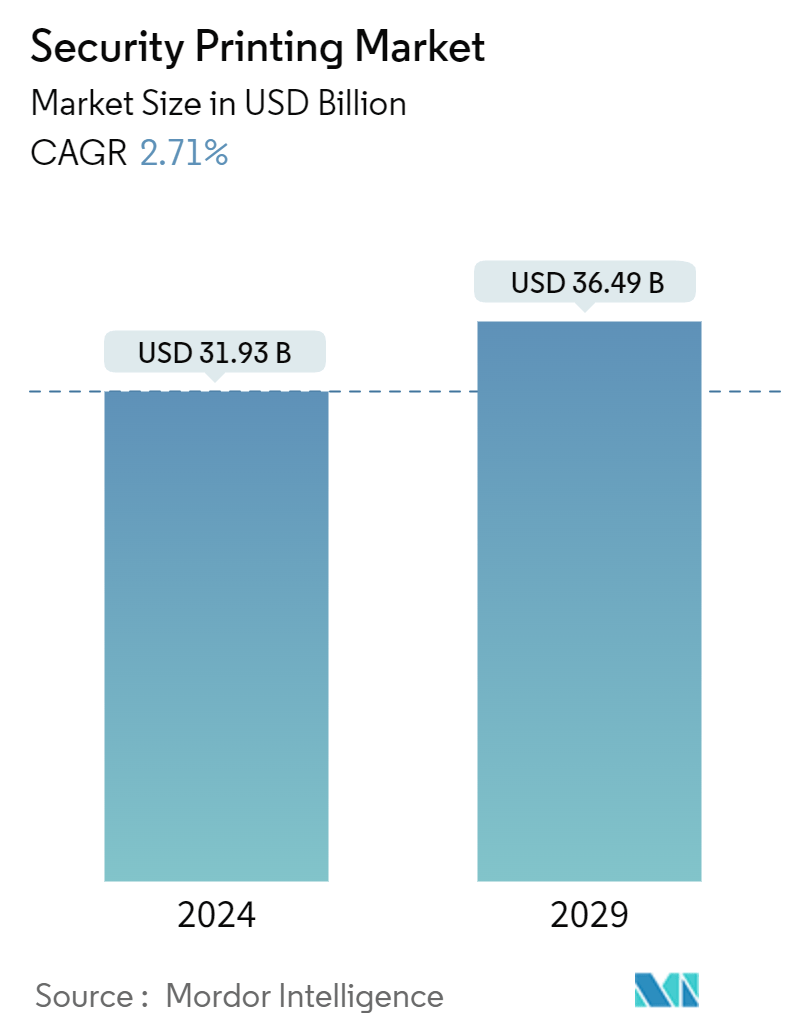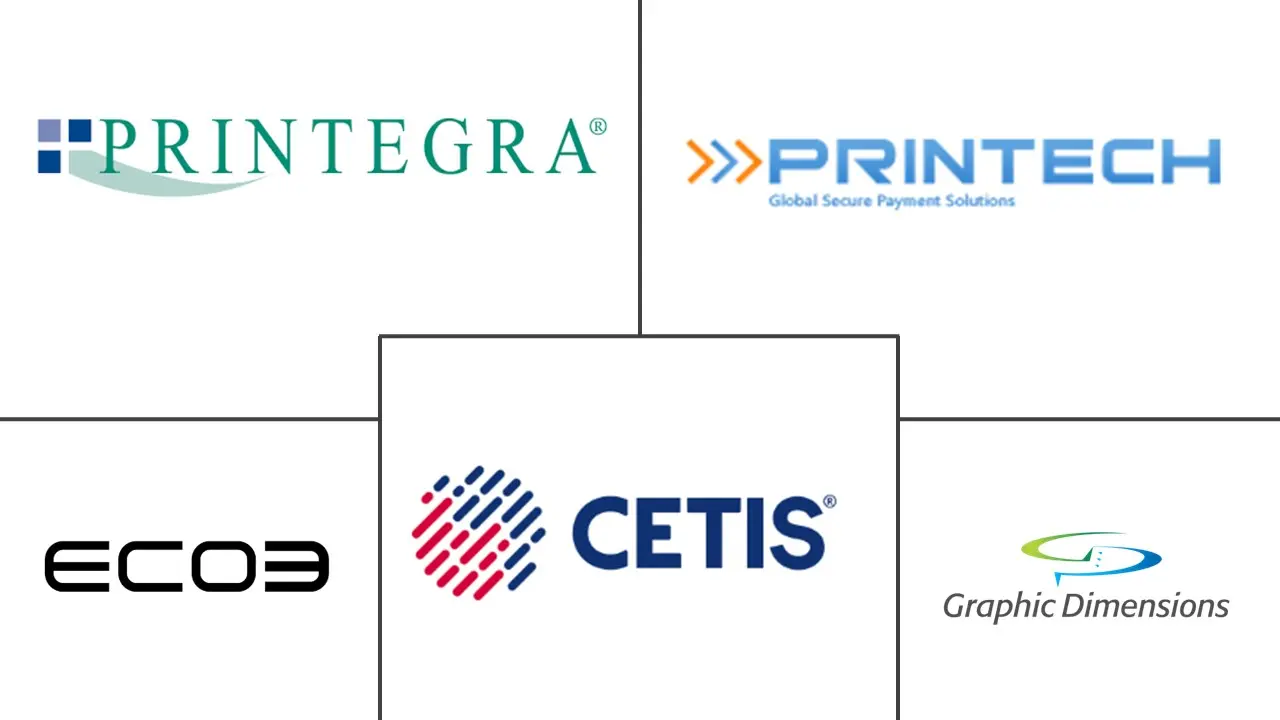Market Size of Security Printing Industry

| Study Period | 2019 - 2029 |
| Market Size (2024) | USD 31.93 Billion |
| Market Size (2029) | USD 36.49 Billion |
| CAGR (2024 - 2029) | 2.71 % |
| Fastest Growing Market | Asia Pacific |
| Largest Market | Asia Pacific |
| Market Concentration | Medium |
Major Players
*Disclaimer: Major Players sorted in no particular order |
Security Printing Market Analysis
The Security Printing Market size is estimated at USD 31.93 billion in 2024, and is expected to reach USD 36.49 billion by 2029, growing at a CAGR of 2.71% during the forecast period (2024-2029).
- As counterfeiting can cause both monetary and reputation loss to the organizations, to assure the user that the product is not tampered with after leaving the factory and is authentic, implementing security measures becomes highly important for the organizations. The increasing number of counterfeit attacks on banknotes, cheques, ID cards, and other services will significantly drive the growth of the security printing market.
- In addition, technological advancements in the government and corporate sectors fuel the need for security printing services. These advancements strengthen documents and products' security, efficiency, and reliability by incorporating advanced features like biometrics, smart cards, digital watermarks, and secure inks. These features ensure that printed materials become significantly resistant to counterfeiting and fraud, amplifying the demand for security printing services.
- For instance, Thales manufactures smart cards for secure financial transactions, including credit and debit cards with embedded chips that enhance security compared to traditional magnetic stripe cards. The company is also a significant player in providing EMV (Europay, MasterCard, and Visa) smart cards that are widely used for secure payment transactions. Further, in October 2023, Thales Brings Passwordless Fingerprint Authentication to the Enterprise. The latest SafeNet IDPrime FIDO Bio Smart Card offers an easy, secure, and quick way to access applications with just their fingerprint. Such inventions in the smart cards for organizational use may further create opportunities in the studied market.
- However, the substantial cost of deploying advanced security printing technologies poses a challenge to the market's growth. Integrating advanced features like holograms, specialized inks, and security threads can significantly increase production expenses. This challenge is especially pronounced for small and medium-sized enterprises operating on constrained budgets.
- Furthermore, the ongoing demand for R&D to outpace counterfeiters and tackle emerging security risks further amplifies the financial burden. These cost challenges have the potential to impede the uptake of security printing solutions, thereby restraining market growth.
- International conflicts, trade policies, economic sanctions, regulatory changes, and political instability are geopolitical factors affecting the security printing market. International conflicts and wars have significantly influenced the security printing market. They have heightened the need for secure documents like passports, visas, and military IDs, disrupted supply chains, and altered regulatory mandates. For instance, Due to the Russia-Ukraine Conflict, there is Increased demand for secure documents such as passports, visas, and ID cards for displaced individuals and refugees.
- However, disruption of supply chains and manufacturing processes due to sanctions and restricted trade with Russia affects the availability of raw materials and technology. In addition, according to the Stockholm International Peace Research Institute, Russia is projected to increase its military spending to 7.1% of its GDP in 2024, constituting 35% of its total government expenditure. Such expenditures on military security may further create opportunities for the studied market in the forecasted period.
Security Printing Industry Segmentation
Security printing involves printing items such as banknotes, cheques, passports, product authentication, stock certificates, postage stamps, and identity cards. The main goal of security printing is to prevent forgery, tampering, or counterfeiting through the printing process under financial, personal ID, and ticket sectors.
The security printing market is segmented by application type (banknotes, payment cards, cheques, personal ID, ticketing, stamps, other application type) and by geography (North America, Europe, Asia Pacific, Latin America, Middle East, and Africa). The market sizes and forecasts are provided in value (USD) for all the above segments.
| By Application Type | |
| Banknotes | |
| Payment Cards | |
| Cheques | |
| Personal ID | |
| Ticketing | |
| Stamps | |
| Other Application Type |
| By Geography*** | |
| North America | |
| Europe | |
| Asia | |
| Australia and New Zealand | |
| Middle East and Africa | |
| Latin America |
Security Printing Market Size Summary
The security printing market is poised for steady growth over the forecast period, driven by the increasing need to combat counterfeiting and enhance document security. As organizations face the dual threats of financial loss and reputational damage due to counterfeit attacks on banknotes, cheques, ID cards, and other services, the demand for security printing solutions is expected to rise. Technological advancements in both government and corporate sectors are further propelling this demand, as features like biometrics, smart cards, digital watermarks, and secure inks are integrated to bolster the security, efficiency, and reliability of printed materials. However, the high cost of deploying these advanced technologies presents a challenge, particularly for small and medium-sized enterprises with limited budgets. Geopolitical factors, such as international conflicts and trade policies, also impact the market by influencing the demand for secure documents and affecting supply chains.
The Asia-Pacific region is anticipated to experience significant growth, driven by the adoption of advanced security printing technologies in countries like India, China, and Japan. The region's market expansion is supported by government initiatives to combat counterfeiting and the increasing use of security printing solutions across various industries. The rise in counterfeit activities, particularly in banknotes, is a key factor fueling this demand. Major players in the market, such as ECO3, Graphic Dimensions Inc., and Printech Global Secure Payment Solutions, are actively pursuing partnerships and acquisitions to enhance their offerings and maintain a competitive edge. Investments in new facilities and technologies, such as the construction of a security printing plant in Ethiopia, further underscore the market's growth potential.
Security Printing Market Size - Table of Contents
-
1. MARKET INSIGHTS
-
1.1 Market Overview
-
1.2 Industry Value Chain Analysis
-
1.3 Industry Attractiveness - Porter's Five Forces Analysis
-
1.3.1 Bargaining Power of Suppliers
-
1.3.2 Bargaining Power of Buyers
-
1.3.3 Threat of New Entrants
-
1.3.4 Threat of Substitutes
-
1.3.5 Intensity of Competitive Rivalry
-
-
1.4 Impact of Geo-political and Economic Factor on the Industry
-
-
2. MARKET SEGMENTATION
-
2.1 By Application Type
-
2.1.1 Banknotes
-
2.1.2 Payment Cards
-
2.1.3 Cheques
-
2.1.4 Personal ID
-
2.1.5 Ticketing
-
2.1.6 Stamps
-
2.1.7 Other Application Type
-
-
2.2 By Geography***
-
2.2.1 North America
-
2.2.2 Europe
-
2.2.3 Asia
-
2.2.4 Australia and New Zealand
-
2.2.5 Middle East and Africa
-
2.2.6 Latin America
-
-
Security Printing Market Size FAQs
How big is the Security Printing Market?
The Security Printing Market size is expected to reach USD 31.93 billion in 2024 and grow at a CAGR of 2.71% to reach USD 36.49 billion by 2029.
What is the current Security Printing Market size?
In 2024, the Security Printing Market size is expected to reach USD 31.93 billion.

